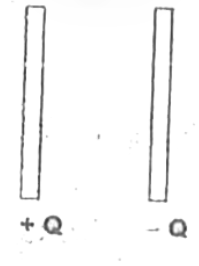A parallel plate capacitors of plate area A has a total surface charge density +σ on one plate and a total surface charge density −σ on the other plate. The force one plate due to the other plate is given by :
σ2A22ε0
σ2A2ε0
σ2A2ε0
σ2Aε0
The correct Answer is:C
To find the force on one plate of a parallel plate capacitor due to the other plate, we can follow these steps:
1. Understanding the Charge Distribution:
- We have two plates of a parallel plate capacitor. One plate has a surface charge density of +σ and the other has a surface charge density of −σ. The area of each plate is A.
2. Electric Field Due to One Plate:
- The electric field E created by a single infinite plate with surface charge density σ is given by the formula:
E=σ2ϵ0
- For the plate with charge density −σ, the electric field at the location of the positively charged plate (due to the negatively charged plate) will also be:
E=σ2ϵ0
- The direction of the electric field due to the negative plate is towards the plate, which means it points towards the negative plate.
3. Force on One Plate:
- The force F on a charged plate in an electric field is given by:
F=qE
- Here, q is the charge on the positively charged plate. The charge q can be expressed in terms of surface charge density σ and area A:
q=σA
4. Substituting Values:
- Now substituting q into the force equation:
F=(σA)(σ2ϵ0)
- This simplifies to:
F=σ2A2ϵ0
5. Final Result:
- Therefore, the force on one plate due to the other plate is:
F=σ2A2ϵ0
- We have two plates of a parallel plate capacitor. One plate has a surface charge density of +σ and the other has a surface charge density of −σ. The area of each plate is A.
- The electric field E created by a single infinite plate with surface charge density σ is given by the formula:
E=σ2ϵ0
- For the plate with charge density −σ, the electric field at the location of the positively charged plate (due to the negatively charged plate) will also be:
E=σ2ϵ0
- The direction of the electric field due to the negative plate is towards the plate, which means it points towards the negative plate.
- The force F on a charged plate in an electric field is given by:
F=qE
- Here, q is the charge on the positively charged plate. The charge q can be expressed in terms of surface charge density σ and area A:
q=σA
- Now substituting q into the force equation:
F=(σA)(σ2ϵ0)
- This simplifies to:
F=σ2A2ϵ0
- Therefore, the force on one plate due to the other plate is:
F=σ2A2ϵ0
Topper's Solved these Questions
- CAPACITORSBOOK - VMC MODULES ENGLISHCHAPTER - CAPACITORSEXERCISE - LEVEL 2
40 Videos
- CAPACITORSBOOK - VMC MODULES ENGLISHCHAPTER - CAPACITORSEXERCISE - JEE Main (Archive) LEVEL-1
36 Videos
- CAPACITORSBOOK - VMC MODULES ENGLISHCHAPTER - CAPACITORSEXERCISE - LEVEL 0 (LONG ANSWER TYPE)
3 Videos
- BASIC MATHEMATICS & VECTORSBOOK - VMC MODULES ENGLISHCHAPTER - BASIC MATHEMATICS & VECTORSEXERCISE - Impeccable
50 Videos
- CURRENT ELECTRICITYBOOK - VMC MODULES ENGLISHCHAPTER - CURRENT ELECTRICITYEXERCISE - IN-CHAPTER EXERCISE-F
10 Videos
Similar Questions
A parallel plate capacitor of capacitance 3μF has total charge +15μC on one plate and total charge −15μC on the other plate. The separation between the plates is 1mm. The electric field between the plates has magnitude: (in N/C)
View SolutionA parallel plate capacitor is charged. If the plates are pulled apart
View SolutionIn a parallel plate capacitor with plate area A and charge Q, the force on one plate because of the charge on the other is equal to
View SolutionA parallel plate capacitor of capacitance 1μF has a charge of +2μC on one of the plates and a charge of +4μC on the other. The potential difference developed across the capacitor is
View SolutionA parallel plate capacitor of plate area A and plates separation distance d is charged by applying a potential V0 between the plates. The dielectric constant of the medium between the plates is K. What is the uniform electric field E between the plates of the capacitor ?
View SolutionImagine a light planet revolving around a very massive star in a circular orbit of radius r with direction T. On what power of r, will the square of time period depends if the gravitational force of attraction between the planet and the star is proportional to r−5/2 .
View SolutionOne plate of a capacitor of capacitance 2μF has total charge +10μC and its other plate has total charge +40μC. The potential difference between the plates is (in Volt).
View SolutionA parallel plate vacuum capacitor eith plate area A and separation x has charges+Q and −Q on its plates. The capacitor is disconnected from the source of charge, so the charge on each plate remains fixed.
a. What is the total energy stored in the capacitor?
b. The plates are pulled apart an additional distance each case.
c. If F is the force with which the plates attract each other, the change in the stored energy must equal the work dW=Fdx done in pulling the plates apart. Find an expression for F
d. Energy storage in a capacitor can be limited by the maximum electric field between the plates. What is the ratio of the electric field for the series for parallel combinations?
View SolutionA parallel plate capacitor is charged and then isolated. On increasing the plate separation
View SolutionConsider a parallel plate capacitor having charge Q. Then,

View Solution
